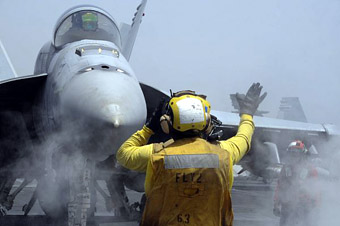
US Navy photo
U.S. to Send More Troops to Iraq
| published June 10, 2015 |
By Thursday Review staff
The White House has authorized sending additional U.S. military forces into troubled Iraq, where Iraqi troops and security forces are weakening in the ongoing battles with the Islamic State. According to earlier press reports, President Obama was considering sending between 500 and 1100 more Americans into the fractured, war torn country. However, in a statement released by the Department of Defense around 1:00 p.m. Wednesday, the Pentagon said the actual number would be about 450.
Currently there are more than 3200 U.S. troops in Iraq serving as advisors, trainers and in some cases coordinators for front line battles and skirmishes between Iraqi soldiers and ISIS militants. The additional U.S. forces would also be limited to advisory and training roles, though some military leaders suggest that some of the Americans may be deployed closer to front-line confrontations.
The press release by the Pentagon said that Defense Secretary Ash Carter intended most of the 450 Americans to supplement training at Taqaddum Air Base in Iraq.
“The intent of this increase,” the Pentagon said, “will be to provide personnel to assist with planning, integration and support of Iraqi security forces and tribal forces as they fight to retake the Ramadi and Fallujah corridor.”
Both the White House and the Pentagon stressed that this was not an escalation per se, nor would it change the parameters of U.S. involvement.
“This decision does not represent a change in mission,” said the Pentagon statement, “but rather adds another location for DoD to conduct similar activities in more areas in Iraq.” Officially, the Pentagon and White House goal is to train between 9,000 and 10,000 Iraqis for the task of confronting ISIS on the ground.
Iraq was the site of a long war in which thousands of Americans and Iraqis died after the overthrow of Saddam Hussein and the resulting sectarian violence. The Sunni-majority nation remained unstable for several years as while U.S. forces and advisors trained a new Iraqi army to take control of security. As part of then-candidate Barack Obama’s pledge to end American involvement in Iraq in 2008, the U. S. formally withdrew from the country in 2011 and 2012.
But the rise of ISIS (also sometimes called ISIL) in 2013 and 2014 threatened to unravel the work of that war. ISIS rose from the chaos and lawlessness of northern Syria during the long civil war between troops loyal to Bashir al Assad and those forces which sought his ouster. ISIS militants invaded Iraq in 2014 and quickly moved across the northern part of the country as the U.S.-trained Iraqi army collapsed. Military and intelligence experts now estimate that ISIS controls one third of Iraq and about 40% of Syria, including areas along the borders with Turkey and Jordan.
In the summer of 2014, the U.S. and other countries—including some Middle Eastern nations—formed a coalition to confront ISIS using a combination of jet fighters, bombing missions, and drone deployments. Though the air campaign—coupled with the introduction of Shiite militias—was at first deemed successful at halting further ISIS advances, it became clear that the air attacks were not enough to dislodge ISIS militants from some areas, and insufficient to stop ISIS from rearming and regrouping for more attacks in new areas. Fierce battles have raged for more than a year for control of some cities, with heavily armed ISIS militants fighting mixed units of Kurdish forces, Shiite militias, and newly trained Iraqi soldiers.
In addition to Saudi Arabia, Qatar, the UAE and Egypt, Jordan upped its participation in the air campaign after one of its pilots was executed by ISIS militants.
Press reports suggest that President Obama will insist that new U.S. forces remain away from front-line battles, but as the war intensifies, many military analysts suggest, the risk to American forces will increase. The training of Iraqi forces has been slow and uneven since last year, and there are deep concerns that some of the newly-armed Iraqis—facing the same dangers and pressures as those soldiers who retreated last year—will be unable to maintain battlefield discipline in the face of future ISIS onslaughts.
The White House and the Pentagon will also announce plans for new training facilities inside Iraq, as well as more comprehensive tools for coordinating the battlefield activities of diverse anti-ISIS forces. The U.S. is also seeking to quickly fill the void left by lower-than-expected participation by Iranian-backed Shiite militias. Iran has said it would send some of its fighters into Iraq to bolster the coalition fight against ISIS, but as yet Tehran has not delivered on the troop numbers originally discussed. Further complicating the task: the Shiite-led government in Baghdad has not been forthcoming with its own promises to deliver thousands of freshly armed and trained fighters to the Sunni areas under siege by ISIS militants, an indication that sectarian differences may still outweigh fears over the Islamic State.
Earlier in the week, Joint Chiefs Chairman Martin Dempsey confirmed to reporters that more Americans were to be sent into Iraq, but at that time Dempsey would not give any indication of how many U.S. soldiers would be sent. Estimates at that time ranged from 500 to 1100, though today’s announcement says that 450, for now, will be sufficient. Dempsey also said that the addition of more forces does not change the overall U.S. strategy in Iraq.
Related Thursday Review articles:
ISIS Militants Take Ramadi; Thursday Review staff; Thursday Review; May 18, 2015.
Obama, Congress & the Fight Against ISIS; Thursday Review; February 23, 2015.
